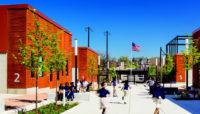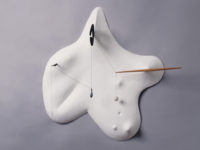To most, the Los Angeles River doesn’t look like much. For the majority of its 51 miles, it winds through the metropolitan area in a concrete flood-control ditch—a setting better suited for chase scenes in films like Grease and Terminator II than, say, a picnic lunch. But its gritty appearance belies its potential to become one of America’s great civic spaces. And, after years of complex—and contentious—revitalization proposals, things seem to be coming together.
The most publicized transformation strategy is being led by Frank Gehry and his team, who were commissioned in 2014 by the city-affiliated nonprofit River LA. More than two years into Phase I, a design has yet to be revealed. But behind the scenes, firm partners Tensho Takemori and Anand Devarajan, with the expertise of landscape firm OLIN and hydrological specialists at Geosyntec, have been in the midst of exhaustive data collection and analysis—an essential first step in getting a preliminary design off the ground. “Everybody’s wondering what it’s going to look like,” says Devarajan. “But if you predetermine that, you are not letting information drive the solution.”
As the L.A. River snakes southward down the California coast, it passes through 17 distinct municipalities, all with different priorities. Over the course of eight months, Takemori and Devarajan staged meetings in almost all of these communities, hearing from civic leaders and residents to identify what their needs were. The architects began to consider how revitalization efforts not only affect obvious issues, like flood control, ecology, and public space, but less tangible qualities, such as social equity and public health.
The Gehry team also needed to build on a large body of existing river research, including a 2007 City of Los Angeles–commissioned master plan, and Alternative 20, an 11-mile revitalization effort led by Mia Leher + Associates and others (news of Gehry’s appointment drew chagrin from activists, who say his involvement undercuts decades of grassroots advocacy). Wanting to make the most of earlier work, the architects asked themselves, “How do we coalesce the data into a single conversation from which people can prioritize?” says Takemori.
Last summer the architects unveiled the LA River Index, a website detailing Takemori and Devarajan’s findings so far. The Index identifies nine issues central to revitalization: flood-risk management, groundwater recharge, water quality, greenhouse gases, ecology and habitat, open space and parks, public health and social equity, transportation, and programming. Each category includes extensive explanations, charts, maps, and data sets.
How such information will translate into a design is yet to be determined. But the architects say that the final scheme will probably take the form of a kit of parts that can be tailored to specific stretches of the river.
Important strides are being made: earlier this month, Los Angeles acquired a 42-acre riverside parcel that will be part of the Alternative 20 plan, an effort that is being pursued concurrently with Gehry Partners’ larger river framework. Meanwhile, the Gehry team hopes to embark on Phase II of their plan by the end of the year, maybe even by summer, if funding permits. It’s a meticulous process and a labor of love, but the architects are committed to doing it right. Says Devarajan, “This is an opportunity for architecture and landscape design to make a difference where it really can.”





Post a comment to this article
Report Abusive Comment